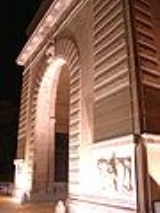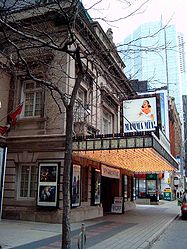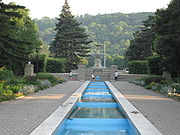
John M. Lyle
Encyclopedia
John MacIntosh Lyle was a Canadian architect, designer, urban planner, and teacher active in the late 19th century and into the first half of the 20th century. He was a leading Canadian architect in the Beaux Arts style and was involved in the City Beautiful movement
in several Canadian cities. In the 1920s, he worked to develop his vision of a uniquely Canadian style of architecture.
, Ireland
on 13 November 1872. He came to Canada as a young child in 1878 and grew up in Hamilton, Ontario
, where his father, Rev. Dr. Samuel Lyle, was minister of Central Presbyterian Church. Lyle attended the Hamilton School of Art. He trained as an architect at Yale University
, enrolling in the Ecole des Beaux-Arts
, in Paris, France, in 1894. Following his graduation, he found work in 1896 with the New York architectural partnership of Howard & Cauldwell. Lyle subsequently became an associate with the New York firm of Carrère and Hastings
—with which he was involved in the design of the New York Public Library
(Fifth Avenue at 42nd St., 1897)—and became a member of the Society of Beaux-arts Architects.
Lyle returned to Canada in 1905 to begin work on the Royal Alexandra Theatre
in Toronto
. In 1906, he established his own company, Atelier Lyle, in Toronto.
During the 1920s, Lyle strove to develop a uniquely Canadian architectural style, incorporating traditional designs from the English and French colonial periods and stone, metal, plaster, fresco, glass and mosaic floral and faunal motifs inspired by the Canadian post-impressionist painters known as the Group of Seven
.
In 1926, the Ontario Association of Architects awarded Lyle its Gold Medal of Honour for his design of the Thornton-Smith Co. Building (1922) on Yonge Street
in Toronto. Two years later, he was elected a Fellow of the Royal Institute of British Architects
. From 1941 to 1944, he served as president of the Art Gallery of Ontario
.
John M. Lyle died in Toronto on 20 December 1945.
Lyle's best-known contribution is Royal Alexandra Theatre
, completed in 1907 in the Beaux-Arts style. It was renovated in 1963 and remains one of the city's valued arts venues.
City Beautiful movement
The City Beautiful Movement was a reform philosophy concerning North American architecture and urban planning that flourished during the 1890s and 1900s with the intent of using beautification and monumental grandeur in cities. The movement, which was originally associated mainly with Chicago,...
in several Canadian cities. In the 1920s, he worked to develop his vision of a uniquely Canadian style of architecture.
Biography
Lyle was born in Connor, County AntrimCounty Antrim
County Antrim is one of six counties that form Northern Ireland, situated in the north-east of the island of Ireland. Adjoined to the north-east shore of Lough Neagh, the county covers an area of 2,844 km², with a population of approximately 616,000...
, Ireland
Ireland
Ireland is an island to the northwest of continental Europe. It is the third-largest island in Europe and the twentieth-largest island on Earth...
on 13 November 1872. He came to Canada as a young child in 1878 and grew up in Hamilton, Ontario
Hamilton, Ontario
Hamilton is a port city in the Canadian province of Ontario. Conceived by George Hamilton when he purchased the Durand farm shortly after the War of 1812, Hamilton has become the centre of a densely populated and industrialized region at the west end of Lake Ontario known as the Golden Horseshoe...
, where his father, Rev. Dr. Samuel Lyle, was minister of Central Presbyterian Church. Lyle attended the Hamilton School of Art. He trained as an architect at Yale University
Yale University
Yale University is a private, Ivy League university located in New Haven, Connecticut, United States. Founded in 1701 in the Colony of Connecticut, the university is the third-oldest institution of higher education in the United States...
, enrolling in the Ecole des Beaux-Arts
École des Beaux-Arts
École des Beaux-Arts refers to a number of influential art schools in France. The most famous is the École nationale supérieure des Beaux-Arts, now located on the left bank in Paris, across the Seine from the Louvre, in the 6th arrondissement. The school has a history spanning more than 350 years,...
, in Paris, France, in 1894. Following his graduation, he found work in 1896 with the New York architectural partnership of Howard & Cauldwell. Lyle subsequently became an associate with the New York firm of Carrère and Hastings
Carrère and Hastings
Carrère and Hastings, the firm of John Merven Carrère and Thomas Hastings , located in New York City, was one of the outstanding Beaux-Arts architecture firms in the United States. The partnership operated from 1885 until 1911, when Carrère was killed in an automobile accident...
—with which he was involved in the design of the New York Public Library
New York Public Library
The New York Public Library is the largest public library in North America and is one of the United States' most significant research libraries...
(Fifth Avenue at 42nd St., 1897)—and became a member of the Society of Beaux-arts Architects.
Lyle returned to Canada in 1905 to begin work on the Royal Alexandra Theatre
Royal Alexandra Theatre
The Royal Alexandra Theatre is a theatre in Toronto, Ontario, Canada located near King and Simcoe Streets. Built in 1907, the Royal Alex is the oldest continuously operating legitimate theatre in North America.-History:...
in Toronto
Toronto
Toronto is the provincial capital of Ontario and the largest city in Canada. It is located in Southern Ontario on the northwestern shore of Lake Ontario. A relatively modern city, Toronto's history dates back to the late-18th century, when its land was first purchased by the British monarchy from...
. In 1906, he established his own company, Atelier Lyle, in Toronto.
During the 1920s, Lyle strove to develop a uniquely Canadian architectural style, incorporating traditional designs from the English and French colonial periods and stone, metal, plaster, fresco, glass and mosaic floral and faunal motifs inspired by the Canadian post-impressionist painters known as the Group of Seven
Group of Seven (artists)
The Group of Seven, sometimes known as the Algonquin school, were a group of Canadian landscape painters from 1920-1933, originally consisting of Franklin Carmichael , Lawren Harris , A. Y. Jackson , Franz Johnston , Arthur Lismer , J. E. H. MacDonald , and Frederick Varley...
.
In 1926, the Ontario Association of Architects awarded Lyle its Gold Medal of Honour for his design of the Thornton-Smith Co. Building (1922) on Yonge Street
Yonge Street
Yonge Street is a major arterial route connecting the shores of Lake Ontario in Toronto to Lake Simcoe, a gateway to the Upper Great Lakes. It was formerly listed in the Guinness Book of Records as the longest street in the world at , and the construction of Yonge Street is designated an "Event of...
in Toronto. Two years later, he was elected a Fellow of the Royal Institute of British Architects
Royal Institute of British Architects
The Royal Institute of British Architects is a professional body for architects primarily in the United Kingdom, but also internationally.-History:...
. From 1941 to 1944, he served as president of the Art Gallery of Ontario
Art Gallery of Ontario
Under the direction of its CEO Matthew Teitelbaum, the AGO embarked on a $254 million redevelopment plan by architect Frank Gehry in 2004, called Transformation AGO. The new addition would require demolition of the 1992 Post-Modernist wing by Barton Myers and Kuwabara Payne McKenna Blumberg...
.
John M. Lyle died in Toronto on 20 December 1945.
Lyle's best-known contribution is Royal Alexandra Theatre
Royal Alexandra Theatre
The Royal Alexandra Theatre is a theatre in Toronto, Ontario, Canada located near King and Simcoe Streets. Built in 1907, the Royal Alex is the oldest continuously operating legitimate theatre in North America.-History:...
, completed in 1907 in the Beaux-Arts style. It was renovated in 1963 and remains one of the city's valued arts venues.
Works
| Project | Location | Dates | Notes | Source | Image |
|---|---|---|---|---|---|
| Royal Alexandra Theatre Royal Alexandra Theatre The Royal Alexandra Theatre is a theatre in Toronto, Ontario, Canada located near King and Simcoe Streets. Built in 1907, the Royal Alex is the oldest continuously operating legitimate theatre in North America.-History:... |
284 King Street West, Toronto Toronto Toronto is the provincial capital of Ontario and the largest city in Canada. It is located in Southern Ontario on the northwestern shore of Lake Ontario. A relatively modern city, Toronto's history dates back to the late-18th century, when its land was first purchased by the British monarchy from... |
1907 | Beaux Arts | W |  |
| Central Presbyterian Church | Hamilton, Ontario Hamilton, Ontario Hamilton is a port city in the Canadian province of Ontario. Conceived by George Hamilton when he purchased the Durand farm shortly after the War of 1812, Hamilton has become the centre of a densely populated and industrialized region at the west end of Lake Ontario known as the Golden Horseshoe... |
1908 | Beaux-Arts |  |
|
| Cobalt railway station Cobalt railway station The Cobalt Railway Station is located in the town of Cobalt in Ontario. It is a stop for Ontario Northland's Northlander trains.The station itself is occupied by the offices of the Historic Cobalt Corporation and the Bunker Military Museum; passengers must wait outside to flag down the train and... |
Cobalt, Ontario Cobalt, Ontario Cobalt is a town in the district of Timiskaming, province of Ontario, Canada, with a population of 1,223 In 2001 Cobalt was named "Ontario's Most Historic Town" by a panel of judges on the TV Ontario program Studio 2, and in 2002 the area was designated a National Historic Site.-History:Silver was... |
1910 | |||
| Union Station Union Station (Toronto) Union Station is the major inter-city rail station and a major commuter rail hub in Toronto, located on Front Street West and occupying the south side of the block bounded by Bay Street and York Street in the central business district. The station building is owned by the City of Toronto, while the... |
Front Street West Front Street (Toronto) Front Street is an east-west road in downtown Toronto, Ontario, Canada. The street marks the rough outline of the shoreline of Lake Ontario as it existed during the original English settlement of York, then called Palace Street... , Toronto |
1915–1927 | In the Beaux-Arts style, Canada's most monumental railway station. G.A. Ross and R.H. Macdonald Ross and Macdonald Ross and Macdonald was one of Canada's most notable architecture firms in the early 20th century. Based in Montreal, Quebec, the firm originally operated as a partnership between George Allen Ross and David MacFarlane from 1907 to 1912. MacFarlane retired in 1913, and Robert Henry Macdonald... , Hugh Jones (CPR) and John M. Lyle. |
W |  |
| Thornton-Smith Co. Building | 340 Yonge Street Yonge Street Yonge Street is a major arterial route connecting the shores of Lake Ontario in Toronto to Lake Simcoe, a gateway to the Upper Great Lakes. It was formerly listed in the Guinness Book of Records as the longest street in the world at , and the construction of Yonge Street is designated an "Event of... , Toronto |
1922 | Beaux-Arts. Lyle won the Ontario Association of Architects' Gold Medal of Honour for this building in 1926. | ||
| Commemorative Arch | Royal Military College of Canada Royal Military College of Canada The Royal Military College of Canada, RMC, or RMCC , is the military academy of the Canadian Forces, and is a degree-granting university. RMC was established in 1876. RMC is the only federal institution in Canada with degree granting powers... , Kingston, Ontario Kingston, Ontario Kingston, Ontario is a Canadian city located in Eastern Ontario where the St. Lawrence River flows out of Lake Ontario. Originally a First Nations settlement called "Katarowki," , growing European exploration in the 17th Century made it an important trading post... |
1923 | Beaux-Arts |  |
|
| Bank of Nova Scotia | 123 Sparks Street Sparks Street Sparks Street is a street in downtown Ottawa, Canada that was converted into an outdoor pedestrian street in 1966, making it the earliest such street or mall in North America.... , Ottawa Ottawa Ottawa is the capital of Canada, the second largest city in the Province of Ontario, and the fourth largest city in the country. The city is located on the south bank of the Ottawa River in the eastern portion of Southern Ontario... |
1923 | Beaux-Arts | http://www.historicplaces.ca/en/rep-reg/place-lieu.aspx?id=16481&pid=0 | |
| Gage Park Memorial Fountain | Gage Park, Hamilton, Ontario Hamilton, Ontario Hamilton is a port city in the Canadian province of Ontario. Conceived by George Hamilton when he purchased the Durand farm shortly after the War of 1812, Hamilton has become the centre of a densely populated and industrialized region at the west end of Lake Ontario known as the Golden Horseshoe... |
1927 | Beaux-Arts |  |
|
| Bank of Nova Scotia | 125 8 Avenue SW, Calgary Calgary Calgary is a city in the Province of Alberta, Canada. It is located in the south of the province, in an area of foothills and prairie, approximately east of the front ranges of the Canadian Rockies... |
1929 | Beaux-Arts | http://www.historicplaces.ca/en/rep-reg/place-lieu.aspx?id=5134 | |
| Bank of Nova Scotia head office and Halifax main branch | 1709 Hollis Street, Halifax, Nova Scotia | 1929 | Beaux-Arts | ||
| Runnymede Library | Toronto | 1930 | A branch of the Toronto Public Library Toronto Public Library Toronto Public Library is a public library system based in Toronto, Ontario, Canada. It is the largest public library system in Canada and in 2008, had averaged a higher... . Incorporates elements of English and French colonial architecture in Canada and uses Canadian imagery for ornamentation. |
||
| Cowan House | 174 Teddington Park Avenue, Lawrence Park Lawrence Park, Toronto Lawrence Park is one of Toronto, Canada's most affluent residential neighbourhoods, along with Rosedale, the Bridle Path, and Forest Hill. It is also one of the wealthiest neighbourhoods in Canada.... , Toronto |
1931 | |||
| Whitney Hall | University College, Toronto | 1930-31 | Georgian Georgian architecture Georgian architecture is the name given in most English-speaking countries to the set of architectural styles current between 1720 and 1840. It is eponymous for the first four British monarchs of the House of Hanover—George I of Great Britain, George II of Great Britain, George III of the United... Revival university residence. |
||
| Thomas B. McQuesten High Level Bridge | Hamilton, Ontario | 1932 | Beaux-Arts monumental entrance bridge to the city of Hamilton characteristic of the City Beautiful movement City Beautiful movement The City Beautiful Movement was a reform philosophy concerning North American architecture and urban planning that flourished during the 1890s and 1900s with the intent of using beautification and monumental grandeur in cities. The movement, which was originally associated mainly with Chicago,... . |
 |
|
| Bank of Nova Scotia head office Scotia Plaza Scotia Plaza is a Postmodern commercial office complex in the city of Toronto, Ontario, Canada. The complex is situated in the financial district of the downtown core, and is generally bordered by Yonge Street on the east, King Street West on the south, Bay Street on the west, and Adelaide Street... |
Toronto | 1951 | Designed in 1928 and built after Lyle's death to a modified design. | ||

